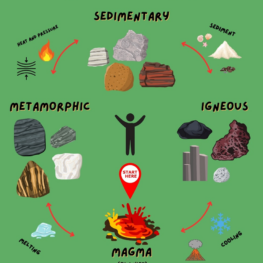 Rocks Rock!
Rocks Rock!
(PreK – 5th grade)
“Rocks Rock!” is a fun and immersive adventure where learners embody a rock’s journey through the rock cycle through play and sensory learning. Come with us as we walk, tumble, wiggle, and explode through various stages in the cycle that include real rock samples which students can touch and observe! The lesson features local NJ rocks, which helps foster a sense of geologic connection and context.
Learn More
Students will develop an understanding of how rocks form and the different types of rocks that are created by touching and interacting with unique rock types from NJ to around the USA. We will define the 3 main types of rocks and their properties as we navigate through the rock cycle. By physically acting out the processes in the rock cycle (such as crouching our bodies to represent the compression of rock layers) students will use their bodies and minds to develop an understanding of each process.
Please see the rock cycle map below that we will experience.
Rocks range in size from large boulders to small stones.
(Optional) The group can take a scavenger hunt to find local rocks and features. What stories can they tell us?
NGSS Standards
| Grade 2
|
2-PS1-1 |
Plan and conduct an investigation to describe and classify different kinds of materials by their observable properties. |
| Grade 2 |
2-PS1-2 |
Analyze data obtained from testing different materials to determine which materials have the properties that are best suited for an intended purpose. |
| Grade 4 |
4-ESS1-1 |
Identify evidence from patterns in rock formations and fossils in rock layers to support an explanation for changes in landscape over time. |
| Grade 5 |
5-ESS2-1 |
Develop a model using an example to describe ways the geosphere, biosphere, hydrosphere, and/or atmosphere interact. |
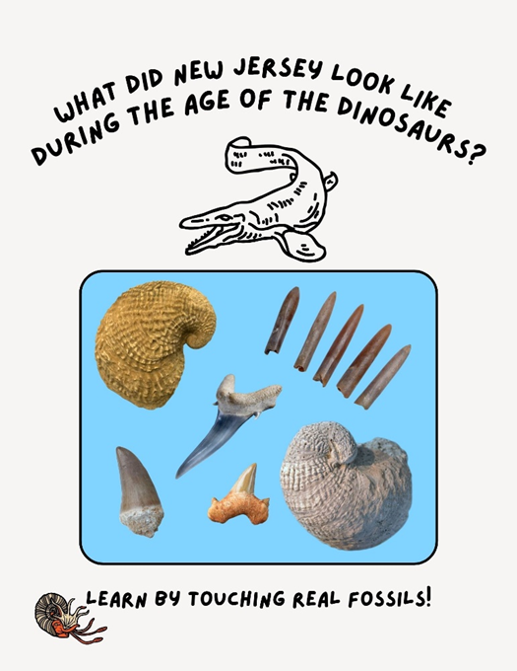 Fun with Fossils
Fun with Fossils
(Grade 3 – HS)
Learners are transported back millions of years as they touch and observe real fossils from when dinosaurs roamed NJ and beyond! We will develop an understanding of how fossils are created, the main types of fossils, and why studying the past can help humans save the future. Students help demonstrate the process of fossilization by making their own mold and cast fossils.
Learn More
This lesson will immerse students in the excitement of studying ancient life on earth. We will cover the basic definitions of what fossils are, modeling how fossils can be created, and experiment with making our own fossil impression.
Once we cover our basics, we’ll investigate real fossil specimens from a time when dinosaurs roamed NJ and was mostly under an ocean (90-70myo). Specimens include extinct oyster shells, squid parts, fish and shark teeth, and a mighty mosasaur tooth! Please see an example of a display below.
NGSS Standards
| Grade 2 |
2-PS1-4 |
Construct an argument with evidence that some changes caused by heating or cooling can be reversed and some cannot |
| Grade 3 |
3-LS3-2 |
Use evidence to support the explanation that traits can be influenced by the environment |
| Grade 3 |
3-LS4-1 |
Analyze and interpret data from fossils to provide evidence of the organisms and the environment in which they lived long ago. |
| Grade 3 |
3-LS4-3 |
Construct an argument with evidence that in a particular habitat some organisms can survive well, some less well, and others not at all. |
| Grade 4 |
4-ESS1-1 |
Identify evidence from patterns in rock formations and fossils in rock layers to support an explanation for changes in landscape over time. |
| Grade 5 |
5-ESS2-1 |
Develop a model using an example to describe ways the geosphere, biosphere, hydrosphere, and/or atmosphere interact. |
| Grade 7 |
MS-LS2-1 |
Analyze and interpret data to provide evidence for the effects of resource availability on organisms and populations of organisms in ecosystems. |
| Grade 7 |
MS-LS2-4 |
Construct an argument supported by empirical evidence that changes to physical or biological components of an ecosystem affect populations. |
| Grade 8 |
MS-LS4-1 |
Analyze and interpret data for patterns in the fossil record that document the existence, diversity, extinction, and change of life forms throughout the history of life on Earth under the assumption that natural laws operate today as in the past. |
| Grade 8 |
MS-LS4-2 |
Apply scientific ideas to construct an explanation for the anatomical similarities and differences among modern organisms and between modern and fossil organisms to infer evolutionary relationships. |
| High School |
HS-LS2-6 |
Evaluate the claims, evidence, and reasoning that the complex interactions in ecosystems maintain relatively consistent numbers and types of organisms in stable conditions, but changing conditions may result in a new ecosystem. |
| High School |
HS-LS4-5 |
Evaluate the evidence supporting claims that changes in environmental conditions may result in: 1) increases in number of individuals of some species, 2) the emergence of new species over time, and 3) the extinction of other species. |
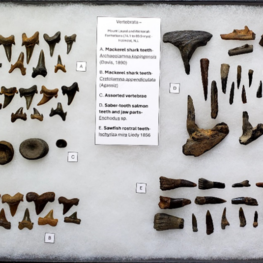 Climate Change: The End of the Ice Ages
Climate Change: The End of the Ice Ages
(Grade 3 – HS)
Students are guided through exciting activities that will model how climate cycles effect the earth and its population. Behold the power of glaciers in a fun experiment. Put on your paleontology hat and examine teeth casts from Ice Age and modern animals to discover how fauna have changed over the last 14,000 years.
Learn More
This lesson’s two main activities are guaranteed to engage the whole class. First, we will do an experiment to see how giant glaciers can move boulders using a miniature model where students push their ice cube “glacier” on a clay landscape to see how it pushes soil and rocks like a bulldozer!
Next, we will observe and feel evidence from the last glacier in the form of local rocks that were pushed by glaciers from miles away. Can you spot them outside?
The final mystery of the climate puzzle we will investigate is fossil evidence. Students will examine teeth casts from Ice Age to modern animals to discover how fauna have changed over the last 14,000 years. Learners are guided through questions to recognize how both climate and European influence altered the population demographics.
NGSS Standards
| Grade 2 |
2-PS1-4 |
Construct an argument with evidence that some changes caused by heating or cooling can be reversed and some cannot |
| Grade 3 |
3-LS3-2 |
Use evidence to support the explanation that traits can be influenced by the environment |
| Grade 3 |
3-LS4-1 |
Analyze and interpret data from fossils to provide evidence of the organisms and the environment in which they lived long ago. |
| Grade 3 |
3-LS4-3 |
Construct an argument with evidence that in a particular habitat some organisms can survive well, some less well, and others not at all. |
| Grade 3 |
3-LS4-4 |
Make a claim about the merit of a solution to a problem caused when the environment changes and the types of plants and animals that live there my change. |
| Grade 4 |
4-ESS1-1 |
Identify evidence from patterns in rock formations and fossils in rock layers to support an explanation for changes in landscape over time. |
| Grade 5 |
5-ESS2-1 |
Develop a model using an example to describe ways the geosphere, biosphere, hydrosphere, and/or atmosphere interact. |
| Grade 7 |
MS-LS2-1 |
Analyze and interpret data to provide evidence for the effects of resource availability on organisms and populations of organisms in ecosystems. |
| Grade 7 |
MS-LS2-4 |
Construct an argument supported by empirical evidence that changes to physical or biological components of an ecosystem affect populations. |
| Grade 8 |
MS-LS4-1 |
Analyze and interpret data for patterns in the fossil record that document the existence, diversity, extinction, and change of life forms throughout the history of life on Earth under the assumption that natural laws operate today as in the past. |
| Grade 8 |
MS-LS4-2 |
Apply scientific ideas to construct an explanation for the anatomical similarities and differences among modern organisms and between modern and fossil organisms to infer evolutionary relationships. |
| High School |
HS-LS2-6 |
Evaluate the claims, evidence, and reasoning that the complex interactions in ecosystems maintain relatively consistent numbers and types of organisms in stable conditions, but changing conditions may result in a new ecosystem. |
| High School |
HS-LS4-5 |
Evaluate the evidence supporting claims that changes in environmental conditions may result in: 1) increases in number of individuals of some species, 2) the emergence of new species over time, and 3) the extinction of other species. |
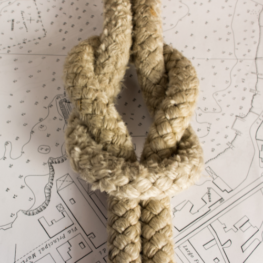 Knot Tying
Knot Tying
(Grade 1 – 5)
Learn the basics of knot-tying. Students will develop their motor, social, and communication skills as they navigate fun knot-tying challenges like a knot-tying relay race and more!
(By request) Group can learn how to use knots to set up a campsite, a tent, and hide your food from hungry critters!
Learn more
Students will develop their fine motor skills as we learn how to tie basic knots with rope and chord. Learn how to tie and use common knots like the square knot, sheet bend, half hitch, and bowline knots.
After we cover the basics we will test our skills in a variety of team-based games designed to develop communication and social skills among students.
Do you have a group who are interested in camping? Please request a short lesson on essential knots for setting up a campsite and a demonstration on how to use rope and knots to make a “bear bag” to store food away at night from hungry animals.
For questions and to schedule one of these programs for your group or class, please contact Lauren at ltheis@raritanheadwaters.org
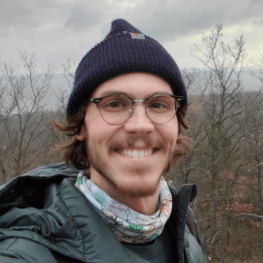 About Kevin Borelli, RHA Educator and Geology/Paleontology Specialist:
About Kevin Borelli, RHA Educator and Geology/Paleontology Specialist:
Kevin Borrelli brings with him 5 years’ experience in outdoor education and early childhood development, as well as a lifelong love for natural science and history. His teaching focuses on experiential and sensory learning that aims to develop curiosity, confidence, and independence in children and young adults. Currently, his curriculum includes unique locally collected artifacts from NJ that emphasize the joy and accessibility of studying the geology, paleontology and other relevant topics in our home state.
 Rocks Rock!
Rocks Rock!  Fun with Fossils
Fun with Fossils  Climate Change: The End of the Ice Ages
Climate Change: The End of the Ice Ages  Knot Tying
Knot Tying  About Kevin Borelli, RHA Educator and Geology/Paleontology Specialist:
About Kevin Borelli, RHA Educator and Geology/Paleontology Specialist: